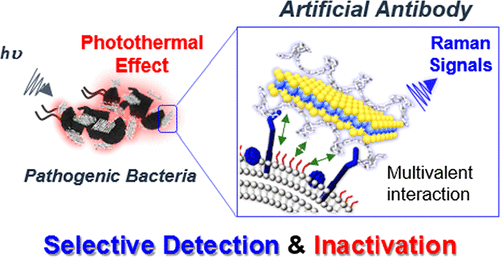当前位置:
X-MOL 学术
›
J. Am. Chem. Soc.
›
论文详情
Our official English website, www.x-mol.net, welcomes your
feedback! (Note: you will need to create a separate account there.)
Transition-Metal Dichalcogenide Artificial Antibodies with Multivalent Polymeric Recognition Phases for Rapid Detection and Inactivation of Pathogens
Journal of the American Chemical Society ( IF 14.4 ) Pub Date : 2021-08-19 , DOI: 10.1021/jacs.1c05458 Sin Lee 1 , Tae Woog Kang 1 , In-Jun Hwang 1 , Hye-In Kim 1 , Su-Ji Jeon 1 , DaBin Yim 1 , Chanhee Choi 1 , Wooic Son 2 , Hyunsung Kim 3 , Chul-Su Yang 2 , Hwankyu Lee 4 , Jong-Ho Kim 1
Journal of the American Chemical Society ( IF 14.4 ) Pub Date : 2021-08-19 , DOI: 10.1021/jacs.1c05458 Sin Lee 1 , Tae Woog Kang 1 , In-Jun Hwang 1 , Hye-In Kim 1 , Su-Ji Jeon 1 , DaBin Yim 1 , Chanhee Choi 1 , Wooic Son 2 , Hyunsung Kim 3 , Chul-Su Yang 2 , Hwankyu Lee 4 , Jong-Ho Kim 1
Affiliation

|
Antibodies are recognition molecules that can bind to diverse targets ranging from pathogens to small analytes with high binding affinity and specificity, making them widely employed for sensing and therapy. However, antibodies have limitations of low stability, long production time, short shelf life, and high cost. Here, we report a facile approach for the design of luminescent artificial antibodies with nonbiological polymeric recognition phases for the sensitive detection, rapid identification, and effective inactivation of pathogenic bacteria. Transition-metal dichalcogenide (TMD) nanosheets with a neutral dextran phase at the interfaces selectively recognized S. aureus, whereas the nanosheets bearing a carboxymethylated dextran phase selectively recognized E. coli O157:H7 with high binding affinity. The bacterial binding sites recognized by the artificial antibodies were thoroughly identified by experiments and molecular dynamics simulations, revealing the significance of their multivalent interactions with the bacterial membrane components for selective recognition. The luminescent WS2 artificial antibodies could rapidly detect the bacteria at a single copy from human serum without any purification and amplification. Moreover, the MoSe2 artificial antibodies selectively killed the pathogenic bacteria in the wounds of infected mice under light irradiation, leading to effective wound healing. This work demonstrates the potential of TMD artificial antibodies as an alternative to antibodies for sensing and therapy.
中文翻译:

具有多价聚合物识别相的过渡金属二硫属化物人工抗体用于病原体的快速检测和灭活
抗体是一种识别分子,可以结合多种靶标,从病原体到具有高结合亲和力和特异性的小分析物,使其广泛用于传感和治疗。然而,抗体存在稳定性低、生产时间长、保质期短、成本高等局限性。在这里,我们报告了一种设计具有非生物聚合物识别相的发光人工抗体的简便方法,用于灵敏检测、快速识别和有效灭活病原菌。在界面处具有中性葡聚糖相的过渡金属二硫属化物 (TMD) 纳米片选择性地识别金黄色葡萄球菌,而带有羧甲基化葡聚糖相的纳米片选择性地识别大肠杆菌O157:H7 具有高结合亲和力。通过实验和分子动力学模拟彻底识别了人工抗体识别的细菌结合位点,揭示了它们与细菌膜成分的多价相互作用对选择性识别的重要性。发光的 WS 2人工抗体无需任何纯化和扩增即可从人血清中快速检测出单拷贝的细菌。此外,MoSe 2人工抗体在光照射下选择性地杀死感染小鼠伤口中的病原菌,导致伤口有效愈合。这项工作证明了 TMD 人工抗体作为传感和治疗抗体替代品的潜力。
更新日期:2021-09-15
中文翻译:

具有多价聚合物识别相的过渡金属二硫属化物人工抗体用于病原体的快速检测和灭活
抗体是一种识别分子,可以结合多种靶标,从病原体到具有高结合亲和力和特异性的小分析物,使其广泛用于传感和治疗。然而,抗体存在稳定性低、生产时间长、保质期短、成本高等局限性。在这里,我们报告了一种设计具有非生物聚合物识别相的发光人工抗体的简便方法,用于灵敏检测、快速识别和有效灭活病原菌。在界面处具有中性葡聚糖相的过渡金属二硫属化物 (TMD) 纳米片选择性地识别金黄色葡萄球菌,而带有羧甲基化葡聚糖相的纳米片选择性地识别大肠杆菌O157:H7 具有高结合亲和力。通过实验和分子动力学模拟彻底识别了人工抗体识别的细菌结合位点,揭示了它们与细菌膜成分的多价相互作用对选择性识别的重要性。发光的 WS 2人工抗体无需任何纯化和扩增即可从人血清中快速检测出单拷贝的细菌。此外,MoSe 2人工抗体在光照射下选择性地杀死感染小鼠伤口中的病原菌,导致伤口有效愈合。这项工作证明了 TMD 人工抗体作为传感和治疗抗体替代品的潜力。











































 京公网安备 11010802027423号
京公网安备 11010802027423号